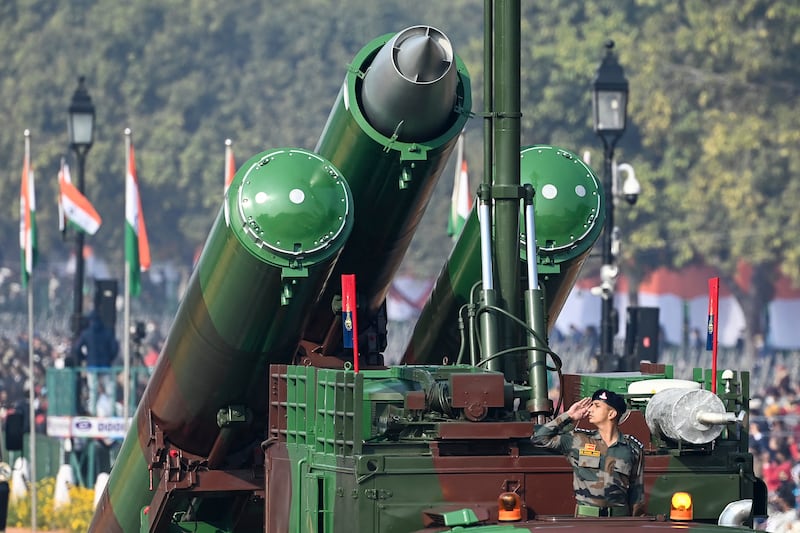The Philippines has agreed to buy a U.S. $375-million package of BrahMos supersonic anti-ship missiles from India, tapping China’s main strategic rival in Asia to shore up its defenses in the disputed South China Sea.
The acquisition of the Brahmos, said to be the world’s fastest cruise missile, marks a breakthrough in efforts to upgrade the Philippines’ defense arsenal, according to an analyst.
On Friday, Defense Secretary Delfin Lorenzana released a document via social media showing that Manila had approved the acquisition of the land-based variant of BrahMos for the Philippine Navy from India’s BrahMos Aerospace Private Ltd.
"As head of procuring entity (HOPE), I recently signed the Notice of Award for the Philippine Navy Shore-Based Anti-Ship Missile Acquisition Project," Lorenzana said on Facebook.
“Negotiated with the government of India, it includes the delivery of three batteries, training for operators and maintainers as well as the necessary Integrated Logistics Support (ILS) package.”
Earlier this week, India said it had successfully test-fired a naval variant of the BrahMos missile from an Indian Navy ship.
“Advanced sea to sea variant of BrahMos Supersonic Cruise missile was tested from INS Visakhapatnam today,” India’s Defense Research and Development Organization said in a tweet
“Missile hit the designated target ship precisely.”
The Coastal Defense Regiment of the Philippine Marines is the unit that will use the land-based variant of the BrahMos PJ-10 missile, produced through a joint venture between India and Russia. The name BrahMos comes from fusing the names of the Brahmaputra and Moscow rivers in India and Russia, respectively.
For India, which has a serious border dispute in its northeast with China, this is the first export order for BrahMos.
As Southeast analyst Derek Grossman said via Twitter: “China won’t be pleased!”
“It’s official, the Philippines is getting India’s BrahMos,” said the senior defense analyst at the RAND Corp., a U.S. think-tank.

A soldier salutes from a truck transporting a BrahMos missile system during India’s Republic Day parade in New Delhi, Jan. 26, 2021. [AFP]
India is only the second new entrant into the Southeast Asia supersonic anti-ship missile game after Russia, said another regional analyst, Collin Koh.
As for the Philippines, it becomes only the third Southeast Asian country after Indonesia and Vietnam to boast an anti-ship supersonic cruise-missile capability, he added.
For Manila “I’ll say it’s more than a breakthrough – it’s practically a leapfrog,” Koh said via Twitter.
Experts see the BrahMos acquisition as a value-for-money option for a developing country with limited cash for defense spending.
“It’s a cost-effective solution for the navy to have a sea-denial capability,” retired navy admiral Rommel Jude Ong, now with the Ateneo School of Government in Manila, told BenarNews in March 2021, when the Philippines and India signed an initial agreement for the supply deal.
“The BrahMos, with a 290-km [180-mile] range, will provide a defensive buffer across a certain extent of the EEZ. It gives the navy a ‘mission-kill’ option in case of conflict,” he said at the time, referring to Manila’s exclusive economic zone in the South China Sea.
Back then, tensions were running high between Manila and Beijing over the presence within the EEZ of some 200 fishing boats believed to be manned by Chinese militias.
The diplomatic standoff went on for months, and although the situation has deescalated, Philippine officials say that unauthorized Chinese vessels remain a constant presence in Philippine-claimed waters of the South China Sea.
Manila, meanwhile, has been in a race to upgrade and modernize its navy, which until recently has had to make do with a fleet of legacy vessels, many of which date back to World War II.
Over the last three years, Manila has acquired its first missile-capable warships: a repurposed corvette from the South Korean navy, and two brand new South Korean-made frigates.
Last month, Manila signed on to acquire two new corvettes from South Korean maker Hyundai Heavy Industries for $554 million. Like the earlier corvette and frigates, these will have anti-ship, anti-submarine and anti-air warfare capabilities.
‘A beginning of India’s arms sales within ASEAN’
For India, the sale of the BrahMos to South China Sea claimant Philippines is a breakthrough in Southeast Asia, where China is a dominant economic force and also claims almost all of the South China Sea.
China’s claims include waters within the EEZs of Taiwan, Brunei, Malaysia, the Philippines and Vietnam. While Indonesia does not regard itself as party to the South China Sea dispute, Beijing claims historic rights to parts of that sea overlapping Indonesia’s exclusive economic zone.
The Philippines’ BrahMos order could lead to more agreements with other Southeast Asian nations, allowing New Delhi to expand its influence in the region, Indian analysts said.
The deal is being “considered a beginning of India’s arms sales within the ASEAN member nations,” Aparaajita Pandey, assistant professor at the Institute of Public Policy at Amity University, told Indian news outlet AsiaNet.
New Delhi is also in talks with Vietnam and Indonesia for the possible sale of supersonic cruise missiles, reports said.
“[The] Philippines is potentially a geo-strategically important strategic partner in the region,” Pandey said.
“The deal will lead to greater militarization of the region, which most definitely will be noticed by Beijing.”
